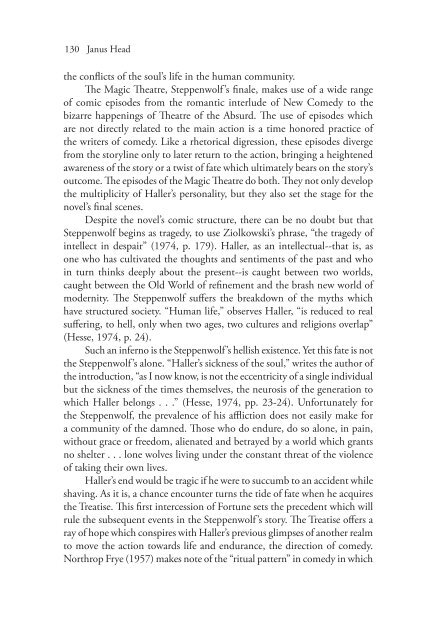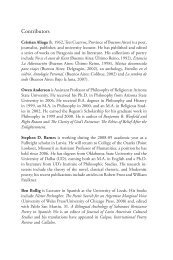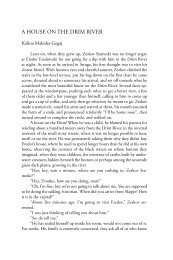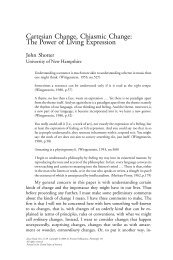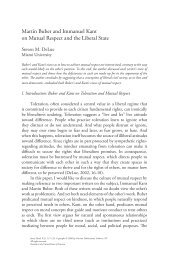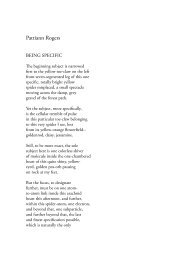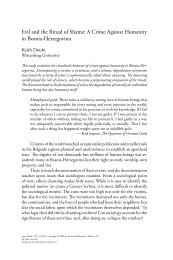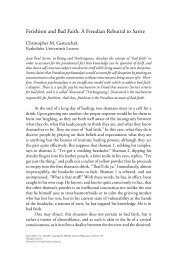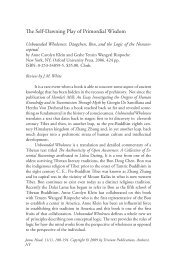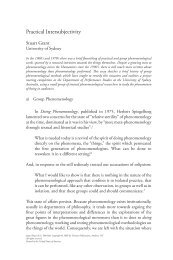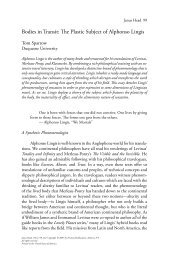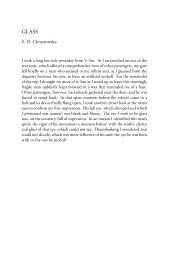Hesse's Steppenwolf: A Comic-Psychological ... - Janus Head
Hesse's Steppenwolf: A Comic-Psychological ... - Janus Head
Hesse's Steppenwolf: A Comic-Psychological ... - Janus Head
Create successful ePaper yourself
Turn your PDF publications into a flip-book with our unique Google optimized e-Paper software.
130 <strong>Janus</strong> <strong>Head</strong><br />
the conflicts of the soul’s life in the human community.<br />
�e Magic �eatre, <strong>Steppenwolf</strong>’s finale, makes use of a wide range<br />
of comic episodes from the romantic interlude of New Comedy to the<br />
bizarre happenings of �eatre of the Absurd. �e use of episodes which<br />
are not directly related to the main action is a time honored practice of<br />
the writers of comedy. Like a rhetorical digression, these episodes diverge<br />
from the storyline only to later return to the action, bringing a heightened<br />
awareness of the story or a twist of fate which ultimately bears on the story’s<br />
outcome. �e episodes of the Magic �eatre do both. �ey not only develop<br />
the multiplicity of Haller’s personality, but they also set the stage for the<br />
novel’s final scenes.<br />
Despite the novel’s comic structure, there can be no doubt but that<br />
<strong>Steppenwolf</strong> begins as tragedy, to use Ziolkowski’s phrase, “the tragedy of<br />
intellect in despair” (1974, p. 179). Haller, as an intellectual--that is, as<br />
one who has cultivated the thoughts and sentiments of the past and who<br />
in turn thinks deeply about the present--is caught between two worlds,<br />
caught between the Old World of refinement and the brash new world of<br />
modernity. �e <strong>Steppenwolf</strong> suffers the breakdown of the myths which<br />
have structured society. “Human life,” observes Haller, “is reduced to real<br />
suffering, to hell, only when two ages, two cultures and religions overlap”<br />
(Hesse, 1974, p. 24).<br />
Such an inferno is the <strong>Steppenwolf</strong>’s hellish existence. Yet this fate is not<br />
the <strong>Steppenwolf</strong>’s alone. “Haller’s sickness of the soul,” writes the author of<br />
the introduction, “as I now know, is not the eccentricity of a single individual<br />
but the sickness of the times themselves, the neurosis of the generation to<br />
which Haller belongs . . .” (Hesse, 1974, pp. 23-24). Unfortunately for<br />
the <strong>Steppenwolf</strong>, the prevalence of his affliction does not easily make for<br />
a community of the damned. �ose who do endure, do so alone, in pain,<br />
without grace or freedom, alienated and betrayed by a world which grants<br />
no shelter . . . lone wolves living under the constant threat of the violence<br />
of taking their own lives.<br />
Haller’s end would be tragic if he were to succumb to an accident while<br />
shaving. As it is, a chance encounter turns the tide of fate when he acquires<br />
the Treatise. �is first intercession of Fortune sets the precedent which will<br />
rule the subsequent events in the <strong>Steppenwolf</strong>’s story. �e Treatise offers a<br />
ray of hope which conspires with Haller’s previous glimpses of another realm<br />
to move the action towards life and endurance, the direction of comedy.<br />
Northrop Frye (1957) makes note of the “ritual pattern” in comedy in which


